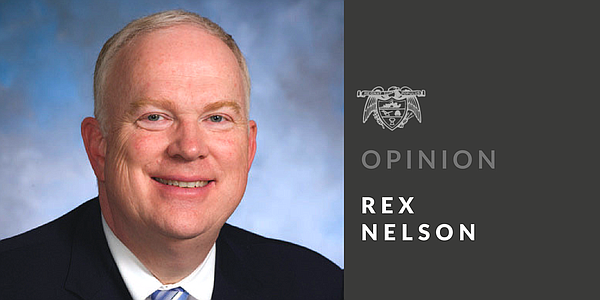
In Saturday's column, I wrote about plans by veteran developer John Flake to renovate the former Arkansas Power & Light Co. building in downtown Little Rock.
There was another tie to the company that's now known as Entergy Arkansas. It was the fact that Flake joined forces in the 1980s with Jerry Maulden, the then-AP&L president, to develop what's now the 40-story Simmons Bank Tower.
AP&L has one of the most interesting histories of any Southern corporation. And its founder, Harvey Couch, was fascinating in his own right.
Here's how Patricia Paulus Laster described Couch for the Central Arkansas Library System's Encyclopedia of Arkansas: "Influenced by a teacher's counsel, Harvey Crowley Couch helped bring Arkansas from an agricultural economy in the early 20th century to more of a balance between agriculture and industry. His persuasiveness with investors from New York and his ingenuity, initiative and energy had a positive effect on Arkansas' national reputation among businessmen."
Couch was born at Calhoun, a community near the Louisiana line in Columbia County, in August 1877. The teacher mentioned was Pat Neff, who encouraged him with adages such as "men like you have built empires." Neff went on to become governor of Texas and president of Baylor University.
Couch achieved success as a railroad and telephone utility entrepreneur. In 1913, he founded Arkansas Power Co. Couch purchased power plants at Arkadelphia and Malvern the following year and built an electrical transmission line between the two cities.
"The system had problems with electrical supply and ran exclusively at night, but it served as the only electrical transmission line in the state," writes historian Kenneth Bridges. "Couch quickly struck a deal with H.H. Foster, owner of Arkansas Land & Lumber Co., to acquire excess sawdust. The sawdust was burned to power his two 550-kilowatt generators. Couch had rechristened the company Arkansas Power & Light Co. by the end of 1914.
"Although a number of Arkansas communities were starting to offer electrical service locally, AP&L became a pioneer in the state by offering reliable service between cities. As Couch expanded the reach of AP&L through the purchase of additional lines and competing providers, he began developing more effective means of electrical generation. He started working with Arkadelphia businessman and steamboat captain Flave Carpenter in 1916 to explore possible sites for hydroelectric dams along the upper Ouachita River."
Business leader Harmon Remmel used his political contacts to help Couch obtain the federal permits needed to build dams on the Ouachita. Couch thus named the first dam Remmel Dam. It was completed in 1924 and created 1,940-acre Lake Catherine, named after Couch's daughter.
Couch named the second dam after Carpenter. It was completed in 1931 and created 7,200-acre Lake Hamilton, named for AP&l's counsel, C. Hamilton Moses.
"Not only did these projects provide vital power for the growing customer base, the two lakes also became recreational landmarks," Bridges writes. "As the utility's success grew in the 1920s, Couch moved to create similar electrical utility giants in neighboring Mississippi (Mississippi Power & Light) and Louisiana (Louisiana Power & Light). By 1930, AP&L had customers in more than 60 Arkansas counties and owned 3,000 miles of transmission lines."
Couch acquired independent electric properties in Jackson, Vicksburg, Columbus and Greenville to form MP&L. In northern Louisiana, meanwhile, Couch took advantage of abundant natural gas. His Sterlington generation facility came online in the late 1920s. It was the largest power plant south of St. Louis with a 30,000-kilowatt capacity.
During the dedication of the Sterlington plant, Gov. Harvey Parnell of Arkansas said: "Harvey Couch has done more to develop these three states--Louisiana, Arkansas and Mississippi--than any other man."
"In 1935, President Franklin D. Roosevelt created the Rural Electrification Administration to bring electricity to rural areas," Bridges writes. "Many rural areas in Arkansas lacked access to electricity in the late 1930s. The REA supported efforts to create local electric cooperatives to speed up electrification. While Couch had been supportive of rural electrification, AP&L balked at the co-op approach and insisted that federal grants and loans for rural power be funneled through AP&L."
Those battles continued long after Couch's death in 1941. Moses replaced Couch as the head of AP&L and remained the company's chairman until 1955.
"In 1949, AP&L (along with LP&L, MP&L and New Orleans Public Service Inc.) came under the newly organized umbrella corporation Middle South Utilities," Bridges writes. "The late 1960s through the 1970s was a time of innovation for AP&L as more advanced generation technologies became available. Instability in the oil supplies of the Middle East made its power an increasing economic necessity."
The system entered the nuclear age in 1968 when AP&L was granted a construction permit to build Arkansas Nuclear One near Russellville. Unit 1 was completed in December 1974. Unit 2 came online six years later.
Back in Little Rock, Flake intends to leave what's known as the AP&L "energy ball" on the roof of the International Style-building constructed in the 1950s. It will remind those of us of a certain age of Reddy Kilowatt, the company's cartoon spokesman for much of the 20th century. It also will remind us of the important role AP&L played in Arkansas history.
Senior Editor Rex Nelson's column appears regularly in the Arkansas Democrat-Gazette. He's also the author of the Southern Fried blog at rexnelsonsouthernfried.com.
"company" - Google News
April 28, 2021 at 03:17PM
https://ift.tt/3dWpCuQ
The power company - Arkansas Online
"company" - Google News
https://ift.tt/33ZInFA
https://ift.tt/3fk35XJ
Bagikan Berita Ini















0 Response to "The power company - Arkansas Online"
Post a Comment